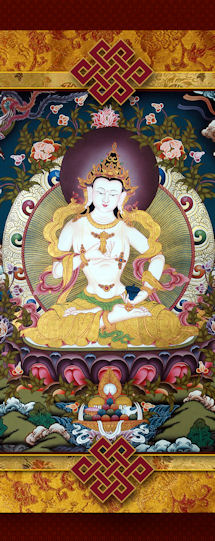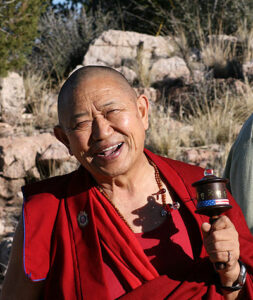Vajrasattva Purification Meditation
 VAJRASATTVA PURIFICATION MEDITATION
VAJRASATTVA PURIFICATION MEDITATIONThe Vajrasattva meditation begins with the visualization of a lotus over the very top of your head. It is important in this meditation that you think of yourself in your ordinary form, not in any transformed condition, but just as your ordinary self, complete with all of your defilements accumulated from beginningless time.
Thinking of yourself in this way, visualize a white lotus on the top of your head. In the middle of the white lotus, on top of the petals, is a white lunar disc. This is the beginning of the visualization— this lotus at the very crown of the head.
The lotus has eight petals and does not necessarily have to be white. It can be red or another color, but it does have eight petals with a lunar disc on top in the center. The lotus is not located at that soft place on a baby’s head where the plates of the skull come together. It’s back a little bit, in the center of the top of the head. Visualize it being a little above there, so the precise spot is not critical.
The white lunar disc on top of the flower is somewhat convex so that the center is raised up. On that convex, white lunar disc is a radiant white syllable HUNG. It stands up on the disc as if it were a needle stuck in the top of a lunar cushion.
The white syllable HUNG then dissolves in light and forms a vajra with five points on each end. This vajra is standing upright on the lunar cushion at this point. In the very center part of the vajra, there is a syllable HUNG.
The syllable HUNG does not appear as something placed in the center of the vajra, but rather it appears as if reflected, as if the center of the vajra were a mirror and it is reflecting an image of the syllable HUNG.
From this syllable HUNG, light radiates in all directions, very powerful and very concentrated. This light is of various colors, all the colors of the rainbow. Each ray of light has at its outermost end various offerings such as flowers, food, incense— all manner of auspicious, beautiful offerings. The light presents these offerings to all the Buddhas and Bodhisattvas in the ten directions. The offerings carried by the rainbow-colored rays of light reach all the Buddhas and Bodhisattvas, infinite in number.
They accept the offerings and, in turn, send their blessings. These come in the form of rays of light, which enter the world of cyclic existence and reach all living beings without exception, melting away and dissolving the residue of their negative activities and defilements. It’s like sunrise on a winter morning when the grass is covered with frost. As the sun’s rays strike the blades of grass, they melt away the frost. In this same way, these rays of blessings strike all living beings of the six realms and melt away their defilements.
Having reached all living beings and purified their defilements, the blessing-rays then return to the vajra which is on the crown of your head and dissolve. They all collect and dissolve into the syllable HUNG in the center of the vajra; his vajra then transforms into Vajrasattva.
Vajrasattva, white in color, is now seated on that lunar disc, which is on the lotus, which is over the crown of your head. As you visualize this, Vajrasattva’s size is not critical; he doesn’t have to be very large. This Vajrasattva is, in fact, the manifestation of all the Buddhas of the three times and ten directions in the form of a single deity. He is understood to be what results when the five Buddha families come together or arise in one form. He is also understood to be, in essence, undifferentiated from one’s own root lama.
His color is the white of a snow mountain. When the bright sun shines on the snow mountain, you get a very brilliant, radiant white— that is the color of Vajrasattva. Vajrasattva has one face and two arms. In his right hand, held in the center of his chest at the heart level, is a crystal vajra with five points held vertically. He holds a bell at his left hip, either on the inside or outside. It is not critical exactly where he is holding the bell. For instance, there is a beautiful statue of Vajrasattva in Bodhgaya with the bell held on the outside of his left hip. Whether the bell is crystal or not is not specified. The left leg is slightly extended.
Vajrasattva wears beautiful ornaments formed of precious jewels from the wish-fulfilling tree of the great celestial paradise. His body ornaments are extremely beautiful jewels in all the colors of the rainbow. His lower garment is made from a special kind of divine silk which is radiant, in all different colors, extremely light and strong. There are said to be thirteen ornaments on his body, these being the ornaments of the body of perfect enjoyment, or the sambhogakaya Buddha. These thirteen include the eight types of jewel ornaments and the five types of divine silk garments.
- The first of the silk ornaments is the head ornament, the one that comes around the ears.
- The second is the one that comes down over the shoulders.
- The third one is the one that goes outward from the waist.
- The fourth goes around the waist like a belt or a girdle.
- The last one is the lower garment of many colors.
The divine jewel ornaments are eight in number.
- The first is the crown across the top of the forehead.
- Second are the two earrings, right and left.
- Next is a type of necklace that goes high around the neck, not very long.
- Fourth is a longer necklace coming down from the neck going down the chest; it has a second loop that goes way down low as far as the knees. Although these seem separate, they are one jewel.
- The two upper arm ornaments make five.
- The two bracelets make six.
- The seventh are ankle bracelets and
- the eighth are foot ornaments around both toes.
Next is the offering to Vajrasattva.
- The first offering is argam, which is the water offered to drink. This is a special divine elixir which is said to possess the eight superior qualities of water.
- Next is padyam, a special pure water specifically for washing the feet.
- Next is the offering of pushpe, the heavenly flowers; and these are offered to adorn Vajrasattva’s ears.
- Next is the offering of dhupe, incense or perfume.
- Next is the offering of aloke, illumination. This would be light of various kinds, like the sun, the moon, stars, special divine butter lamps, things like that.
- Next, the offering of the heavenly ointments, ghande. These are special ointments which have the scent of divine flowers and special medicinal properties. Specifically, certain of these ointments are given in cold weather to warm the body and others in hot weather to cool the body.
- Next offered is newidye, food. These are heavenly foods with hundreds of flavors, extremely delicious, and beautiful to look at.
- The final offering is shapta, music. This is music of various sorts by heavenly musicians, which is most pleasing to the ears of divine beings.
These offerings are of three types: outer, inner, and secret.
After the offering is the praise of Vajrasattva. After the praise is the main visualization. At Vajrasattva’s heart is a convex moon disc, in the center of which stands the syllable HUNG. This syllable HUNG is a brilliant white, almost a silvery white as if it were made of mercury. Around it, beginning with the syllable OM is the 100-syllable mantra which moves about the perimeter of the white lunar disc, circling in a clockwise direction as viewed from above. The syllables of the mantra are in Vajrasattva’s heart on a white lunar disc, going around the syllable HUNG. Each syllable is standing upright just as the central syllable HUNG is. They go around in that circle, each of them giving off rays of white light.
The 100-syllable mantra goes around quickly when you say the recitation quickly and goes around slowly as you say it slowly. As it goes around, it radiates light in all directions, again making offerings to the Buddhas and Bodhisattvas, especially to Vajrasattva, in all directions. Rays of light come back from them and purify the defilements of living beings, transforming each and every living being into Vajrasattva, and then dissolve into the Vajrasattva over the crown of your head.
Then from the big toe of Vajrasattva’s left foot comes a stream of white ambrosia, which flows down into the top of your head. It pushes out all of the defilements and obscurations from the top of your head all the way down and out of the body through the lower orifices. So, you visualize
this radiant white nectar coming into the top of the head, filling the body, and pushing dark, smoky fluid (which is all the defilements and obscurations) out of the body until, in this way, the entire body is perfectly cleansed and filled with this divine elixir.
Vajrasattva’s right foot is slightly extended and the left leg is in the half lotus position. From the big toe of the right foot, the purifying elixir flows from between the nail of the toe and the toe itself. It is as if this were a spigot on a barrel which you open and get a focused stream of water. Now there is a certain difficulty which sometimes arises, especially for beginners, when we try to visualize the process of nectar coming down from the mantra in Vajrasattva’s heart and going out from his big toe down into our head and purifying us of defilements and obscurations. When we think
about it very hard then we’re trying to imagine, “ it’s OK, he’ is seated on this lunar disc and under it there is this lotus and his foot is up on that disc . . . now how exactly is that stream of nectar going to reach my head?” So, we have a problem that may obstruct our meditation. It is said to be okay to visualize purifying nectar collecting in the lotus and then coming out the stem at the bottom of the lotus. The nectar is funneled down into our head and we are purified that way.
However, there is a fault here. Although this type of modification sometimes helps in our initial meditation and visualization, it fosters a misconception about the nature of this process. It’s a sort of clinging to our own limited reality as being ultimate. The nature of ordinary beings is that we are obstructed by physical objects like walls, trees, mountains, and things like that, whereas the nature of enlightened beings is that neither they nor their enlightened activities are obstructed by any type of material or physical obstacle. They are completely unobstructed in their activities, so it’s really not necessary to be concerned about the mechanical process of receiving the flow of nectar. The power of the enlightened ones is to bestow blessings to all beings. From beginningless time, the enlightened beings have showered their blessings on living beings, but it requires a certain receptivity on the part of beings. So, because of that we can just think we are receiving directly these blessings of Vajrasattva.
In conjunction with the Vajrasattva practice, it is absolutely necessary that we practice the four antidotes which neutralize and remove the non-virtues, or negative karma. Without doing this, there is ultimately no way to stop this pernicious process of committing non-virtuous activities and building up defilements. Nor is there any way of ultimately purifying all of our former karma and misdeeds and their residue within
us. So, we must engage in these four powers which act as antidotes to non-virtue.
- The first of these is called the power of regret. Bring to mind or acknowledge the non-virtuous activities that you have performed in the past, both those which you are directly aware of and those which, through inference, you know you have done in this and past lives. Generate a very sincere sense of regret by understanding the evil nature of these activities and their terrible consequences for us in the future if we do not repent and turn away from them. So, here the first power is to regret and turn away from these activities.
- Second is the power of resolve. This is where we make a firm determination, a decision or a vow, not to engage in these activities in the future.
- The third is the power of reliance. This is relying on the superior, or higher, power of the enlightened beings for the resolution of our predicament. This reliance includes the Buddhas and Bodhisattvas, and the Buddha, Dharma, and Sangha. We use the first two powers in relation to this third. In other words, we openly confess what we’ve done in recognition of our misdeeds and their harmful nature, and resolve not to repeat them again. This confession is directed to these superior powers, the Buddhas and Bodhisattvas. Here, Vajrasattva functions in that role. So, we rely on Vajrasattva and other Buddhas and Bodhisattvas while in engaging in this process.
- The fourth power is that of the actual antidote. This would be engaging in some type of activity which will counteract, or neutralize, the non-virtues of the past. This can be one of many types of meditations or Dharma practices, including those like the Four Thoughts that Turn the Mind from Samsara. Especially effective for this is the Vajrasattva practice in which we do this entire meditation and recite the 100-syllable mantra.
So, by engaging in this fourfold process, there is no defilement, no bad karma or misdeed, that cannot be neutralized and removed. With this visualization, the purifying nectar from Vajrasattva enters your head, pushes out all of the defilements which appear as dark fluid and leave the body from the lower orifices. Visualize that this dark fluid is flushed out of the body and falls way down and keeps on going. In this way, your body is completely purified. The defilements of body, speech, and mind are sent far away.
At this point, visualize your body as being pure and without the slightest stain or defilement, like a radiant, pure, crystal vessel. Then turn to Vajrasattva and request in prayer acknowledgment of your activity of purifying yourself. Vajrasattva acknowledges this and says that you are now
purified of all of your sins and defilements. It is important that you understand this, and take that acknowledgment and hold onto it. Understand that you have been purified![]()



